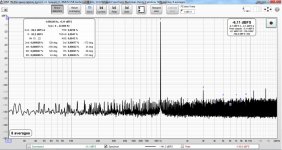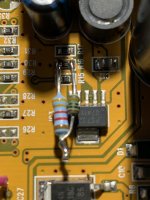Thank's Jan...
@MagicBus... i saw somewhere that John the father of REW wrote this ::
Jesper.
@MagicBus... i saw somewhere that John the father of REW wrote this ::
Might be some monitoring active, e.g. "Listen to this device" selected in the Windows audio properties for the iTwo inputs. The Java setting uses the WDM drivers so anything that is active for Windows will remain active, whereas ASIO bypasses the Windows processing. The mix knob on the iTwo needs to be all the way to Playback as well, but if it wasn't should see that in the ASIO result as well.
Edit: Also make sure the default sample rate in the Windows audio properties is the same as the sample rate in REW when using Java drivers, otherwise the OS will resample between the two rates.
Jesper.
You should really check or ask in the dedicated 'Measurements with R.E.W.' thread.Best results I can get are with ASIO, still not the full monty. With Java is a disaster. From the little I know, Windows and Java have been in conflict... All I can tell is I have installed the latest REW version. Do I need to install Java drivers separately?
My experience was that it was better to have installed a single ASIO driver, and the one which was the more stable with the Behringer was the manufacturer one. A restart was necessary in between steps.
The real msytery for me is: how does lykkedk keep such a clean work area despite all he's doing? 😛
Nice seeing 4 zeroes after the decimal place for sure.Awesome THD+N! Nice work!
I tried some things with my soundcard. I remind you it's not the Behringer, it has a DIYINHK usb to I2S converter and the CS4272 working in stand alone mode in case it matters. I found that WDM doesn't work at all in ARTA, ASIO is fine though. In REW both modes work with ASIO being better than Java -see attached. ASIO is doing pretty much the same as in ARTA however it refuses to go higher than -6dB -I guess it doesn't matter- but most important the spectrum window won't extent beyond 30kHz.
Perhaps it has to do with my idiosyncratic soundcard, I'll have to live with that, no worries actually. Thank you both!
Perhaps it has to do with my idiosyncratic soundcard, I'll have to live with that, no worries actually. Thank you both!
Attachments
This explains a lot, thank you very much! And I just turned to 16-bit in ARTA and now WDM works -inferior to ASIO. I've been thinking for some time to build a Linux machine, it should be soon.
Hi Jesper,Hey guy's... 🙂
I had some conversation with Victor (the guy which are selling the 1KHZ osc.)... I bought one from him recently; today i did some test's with it.
View attachment 1040558
I had as usually some problems with setup picking all kind's of spikes up (mainly 50Hz + 100Hz etc...)
But with Victor's oscillator i can connect the Behringer shield/GND to the Victor's chassis i build the thing into.
When this connection is established, everything is very prone to noise pickup, i can even leave the laptop psu in the mains outlet, without no noticeable noise measured...
Fortunately i didn't had the time yet to do some real DUT measurement's, but i thought that i would like to show this.
I also build an LM317 psu, which i build into an old switcher supply i had.
The LM317 are somewhat stressed, giving it near it's maximum of +40vdc on the input, having some pretty nice +34.8vdc out for the oscillator.
Attached some pictures showing both battery powered and my LM317 supply with the Victor's.
Jesper.
I like to get in contact with Victor concerning his 1 kHz Oscillator.
Please give me the contact data.
Thanks
Alfred
It is a game of trial and error. Preferring Linux I have a double boot system with Win7 as well. My Motu M4 best works with its own drivers on windows. The java drivers suck. And with linux the best I could get was access to 2 channels instead of 4. Behringer should work with Linux as well.This explains a lot, thank you very much! And I just turned to 16-bit in ARTA and now WDM works -inferior to ASIO. I've been thinking for some time to build a Linux machine, it should be soon.
@Alfred ...
The Loop i did yesterday, i see that the 1KHz is a bit out of band (1088Hz).
I was not aware of that, before later. -I checked everything with my scope, and the 1KHz Victors osc. are delivering 1KHz everytime. But sometimes when fiddeling around in REW it happens there (proberly duo to some driverissue or like ?)...
Anyway, when showing the correct 1KHz in REW, the THD numbers are a bit worse than the first measurement i did.
I attached a measurement i did just now here. -No issue for me, just want to show.
Everything is okay
Jesper.
Just PM here... user vicnicI like to get in contact with Victor concerning his 1 kHz Oscillator.
Please give me the contact data.
The Loop i did yesterday, i see that the 1KHz is a bit out of band (1088Hz).
I was not aware of that, before later. -I checked everything with my scope, and the 1KHz Victors osc. are delivering 1KHz everytime. But sometimes when fiddeling around in REW it happens there (proberly duo to some driverissue or like ?)...
Anyway, when showing the correct 1KHz in REW, the THD numbers are a bit worse than the first measurement i did.
I attached a measurement i did just now here. -No issue for me, just want to show.
Everything is okay

Jesper.
Attachments
I did a little writeup of my journey here in Salas's DCG3 thread https://www.diyaudio.com/community/threads/salas-dcg3-preamp-line-headphone.296406/post-6987701
Thank's for all the help i got here @MagicBus @alfredr @YashN etc... etc.. really appreciate all the help, getting my dummy "I" to finally have a new usefull toy 😉
Jesper.
Thank's for all the help i got here @MagicBus @alfredr @YashN etc... etc.. really appreciate all the help, getting my dummy "I" to finally have a new usefull toy 😉
Jesper.
Hi...
I'am doing some experiments with my setup.
When i push it a little i can get the red [CLIP] lamp on the front (left channel) to lighten up.
What actually happens here? -Is it the CS4272 codec which is getting overloaded?


Jesper.
I'am doing some experiments with my setup.
When i push it a little i can get the red [CLIP] lamp on the front (left channel) to lighten up.
- When it happens, i quickly turn it down ofcause.
- It's happening sometimes when i am near the max of the FS (<-4dB) and near max of the input controller of my Magic balanced board.
What actually happens here? -Is it the CS4272 codec which is getting overloaded?
Jesper.
The clipping indicator is another mystery of this soundcard... Clearly it is measuring right at the ADC input but I never managed to trace it. The pcb is multi layer but unlike common practice the inner layers hold signal traces rather than just ground and power planes. I don't know at what point is set to activate. The ADC itself should reach 0dBFS and then clip with input signal 1,13*VA (analog power supply) You could try to see if odd harmonics rise abnormally together with the indicator.
I think it could be duo to the "lowish" supply for the CS4272...The clipping indicator is another mystery of this soundcard... Clearly it is measuring right at the ADC input but I never managed to trace it. The pcb is multi layer but unlike common practice the inner layers hold signal traces rather than just ground and power planes. I don't know at what point is set to activate. The ADC itself should reach 0dBFS and then clip with input signal 1,13*VA (analog power supply) You could try to see if odd harmonics rise abnormally together with the indicator.
And yes i can confirm that THD's are going high, when clipping indicator goes RED.
- Clipping are showing, sometimes near -0dB, sometimes at -4dB.
Jesper.
So, the indicator is true for ADC overloading. I also see clipping below -4dB with REW. I think it depends on calibration. VA<5V doesn't seem to be a problem IMO.
Yes... The indicator is true i suppose.
I tried to raise the voltage to 4.75vdc on the LDO today, verifying that it was stable having 60mV headroom for the IC to accept 40mV headroom.
Everything was okay, and voltage was excatly 4.75vdc. -But THD figures was bad with this?
I donno why this, but maybe the Behringer folk's know 😵 ... Jan did success with this, but he also did other mod's.
I will let it be at 4.5vdc for now, as i got very good result's.
Showing here Loopback with LDO set at 4.75 & 4.5 (stock)
Jesper.


I tried to raise the voltage to 4.75vdc on the LDO today, verifying that it was stable having 60mV headroom for the IC to accept 40mV headroom.
Everything was okay, and voltage was excatly 4.75vdc. -But THD figures was bad with this?
I donno why this, but maybe the Behringer folk's know 😵 ... Jan did success with this, but he also did other mod's.
I will let it be at 4.5vdc for now, as i got very good result's.
Showing here Loopback with LDO set at 4.75 & 4.5 (stock)
Jesper.
When I changed the LDO output voltage (and output voltage only, no other mods done at the same time), THD at high input levels reduced significantly. Analog circuitry simply works better at higher voltages, almost by definition. But why your THD rises, I have no clue. Are you sure you tested with same input gain setting and output level as in previous measurements? Or maybe there was not enough headroom for the LDO to properly regulate the voltage? Did you measure the LDO droput voltage? Just guessing...
Jan
Jan
Hi Jesper,
I cannot imagine the resistors are causing the distortions, but using a same size 0603 resistor will look more professional of course 🙂 .
When I looked at the RTA images again, I noticed that the first one shows a lot of non-harmonic distortion. That's weird... The frequencies are in between the harmonics of the 1kHz fundamental. Could these spikes be crosstalk from signals on the other input and output channels? Again, just guessing...
Jan
I cannot imagine the resistors are causing the distortions, but using a same size 0603 resistor will look more professional of course 🙂 .
When I looked at the RTA images again, I noticed that the first one shows a lot of non-harmonic distortion. That's weird... The frequencies are in between the harmonics of the 1kHz fundamental. Could these spikes be crosstalk from signals on the other input and output channels? Again, just guessing...
Jan
Hi Jan.
I'am sure, that eventhrough that IC states lowdropout of 40mV, and i have ~60mV this is the case.
I cannot see what else it could be.
When you some posts ago wrote that i could use external PSU and USB isolator, did you mean that i should use a USB "Y" cable, which splits the datalines to the PC & the power to external PSU / Battery ?
Jesper.
I'am sure, that eventhrough that IC states lowdropout of 40mV, and i have ~60mV this is the case.
I cannot see what else it could be.
When you some posts ago wrote that i could use external PSU and USB isolator, did you mean that i should use a USB "Y" cable, which splits the datalines to the PC & the power to external PSU / Battery ?
Jesper.
- Home
- Design & Build
- Equipment & Tools
- Behringer UMC 202HD for measurements



